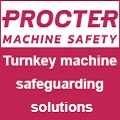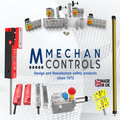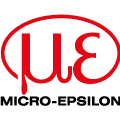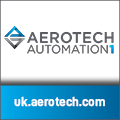
Posted to News on 4th Jun 2014, 09:58
Heat Pipes - Theory, Design and Applications, book review
Jon Severn, the Editor of MachineBuilding.net, reviews Heat Pipes - Theory, Design and Applications, sixth edition, by David Reay, Peter Kew and Ryan McGlen.}
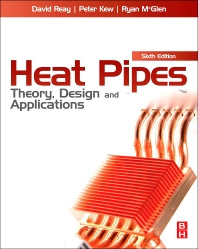
Published by Butterworth-Heinemann, an imprint of Elsevier, the sixth edition of Heat Pipes - Theory, Design and Applications, by David Reay, Peter Kew and Ryan McGlen, is a highly detailed book of over 250 pages. It is now around 40 years since work began on the first edition, and it has been some seven years since the last edition was published, but the sixth edition appears to be as up to date as is possible with a printed book. The publishers describe Heat Pipes as 'The standard resource on heat pipe theory, design and selection.'
Compared with the fifth edition, the new version benefits from fine-tuning to the text, plus new data on thermosyphons, applications and manufacturing methods, and there are comments on the relatively new use of 3D printing for fabricating heat pipes. There is also a new section on nanofluids (fluids containing nanoparticles), substantial additions have been made to the chapter covering special types of heat pipes, and the chapter on electronics cooling applications has been rewritten. Other applications have been reassessed as necessary, though out-dated applications have been retained because the authors felt they still contain valuable information. The sixth edition also has an updated list of websites, while the bibliography has been deleted because there is now so much information available via the internet.
The Heat Pipes book covers the topic in sufficient detail that it will be a very useful reference work for heat pipe designers, but it will also be helpful for users who need an understanding of the underlying technologies if they are to make the most of these increasingly popular "high thermal conductance devices'.
Today, heat pipe technology has advanced to a level at which devices can be manufactured to operate at temperatures from 4K to over 2300K, with an axial heat flux of 10-20kW/cm2 (to put that in context, the heat flux of a heat pipe can easily be several hundred times greater than can be achieved by copper). By far the most prolific application for heat pipes is in desktop and laptop computers, for which millions per month are manufactured and installed to cool microprocessor chips. Other typical applications include nuclear and chemical reactor thermal control, heat recovery and other energy-conservation uses, de-icing, cooking, control of manufacturing process temperatures, thermal management of spacecraft and automotive systems, and in renewable energy devices. Considerable detail is provided in the chapter on heat pipe applications, though a separate chapter is devoted to cooling of electronic components in recognition of the fact that the quantity of applications of this type is several orders of magnitude greater than for any other application.
Book contents
Chapter 1 outlines the historical development of thermosyphons and heat pipes, and also provides a forward view of how the technology might evolve in the future.
Chapter 2 contains detailed theory and tabulated data, as well as a full set of references. Note that additional data is provided in the appendices: working fluid properties; and thermal conductances of heat pipe container and wick materials.
Chapter 3 covers heat pipe components and materials. Since the last edition of the Heat Pipes book, more data has become available relating to the operating life of heat pipes, so the authors have taken the opportunity to update the information. Interestingly, the emergence of additional life data has led the authors to modify their stated preferences for working fluids.
Chapter 4 provides a design guide that will be essential for anyone considering designing their own heat pipe - or users who want to understand the design of a particular device. Heat Pipe design can be divided into four stages:
- Selection of appropriate type and geometry
- Selection of candidate materials
- Evaluation of performance limits
- Evaluation of actual performance
This procedure is illustrated by means of a flow diagram.
Chapter 5 explains heat pipe manufacture and testing, with a particular emphasis on the need for strict quality control. Within this chapter there is a new section on 3D printed heat pipes.
Chapter 6 addresses special types of heat pipes:
- Variable conductance heat pipes (VCHPs)
- Thermal diodes and switches
- Pulsating (oscillating) heat pipes
- LHPs and CPLs (loop heat pipes and capillary pumped loops)
- Microheat pipes
- Use of electrokinetic forces
- Rotating heat pipes
- Miscellaneous types of heat pipe (sorption heat pipes and magnetic fluid heat pipes)
Chapter 7 outlines various applications for heat pipes, as mentioned above. This chapter provides sufficient detail to give readers a feel for the diversity of projects for which heat pipes can be developed, with photographs, diagrams and data as necessary.
Chapter 8 describes commercial heat pipes for cooling electronic devices, which is the most widespread application. This chapter also presents heat pipe technologies that are under development to meet the future needs for this field; the trend towards further miniaturisation results in higher power densities and, therefore, the need for efficient removal of heat from these high-flux devices. As with Chapter 7, a wealth of illustrative material has been included.
Overall, Heat Pipes - Theory, Design and Applications is an excellent book that covers the subject in great depth for the benefit of heat pipe designers and users. Heat pipes are remarkably versatile devices, capable of being manufactured at the very small scale (such as for cooling electronic devices) and on a much larger scale (such as for maintaining permafrost conditions beneath railway tracks). They can also be used in a broad range of temperatures, as well as in demanding environmental conditions such as space and nuclear power plants. Engineers will no doubt continue to stretch the boundaries of heat pipe technology, and this book would be a valuable addition to the technical library of any engineer working with heat pipes.
About the authors
David Reay manages David Reay & Associates, UK, is a Visiting Professor at Heriot-Watt University and Nottingham University, UK, and is also an Honorary Professor at Nottingham University, UK. His main research interests are compact heat exchangers, process intensification and heat pumps. He is also Editor-in-Chief of Applied Thermal Engineering and author/co-author of eight other books.
Ryan McGlen is Senior Advanced Technologies Engineer at Thermacore Europe Ltd, where he leads research and development of future heat pipe technologies. Current research interests include novel heat pipe materials and working fluids combinations, and additive layer manufacture of aluminium heat pipes with complex 3D Sintered Style wicks (SSHP).
Peter Kew first became involved in heat pipes in the late 1970s as a research officer with International Research and Development while working on a range of heat transfer and energy conservation projects, including heat pipe development that was then led by David Reay. He has maintained this interest for over 20 years as a Lecturer and Senior Lecturer at Heriot-Watt University researching evaporative heat transfer. Currently Dr Kew is Associate Head of the School of Engineering and Physical Sciences, Heriot-Watt University, responsible for the School's activities on the Dubai Campus of the University.
Where to buy Heat Pipes - Theory, Design and Applications
Copies of Heat Pipes - Theory, Design and Applications are available directly from the publisher, Elsevier, as well as bookshops and online retailers. Both hard copies and digital downloads can be purchased.
Want the latest machine building news straight to your inbox? Become a MachineBuilding member for free today >>






